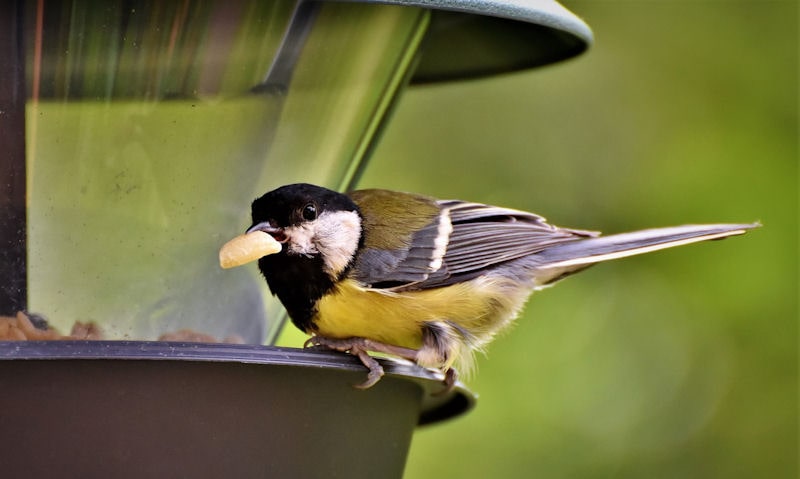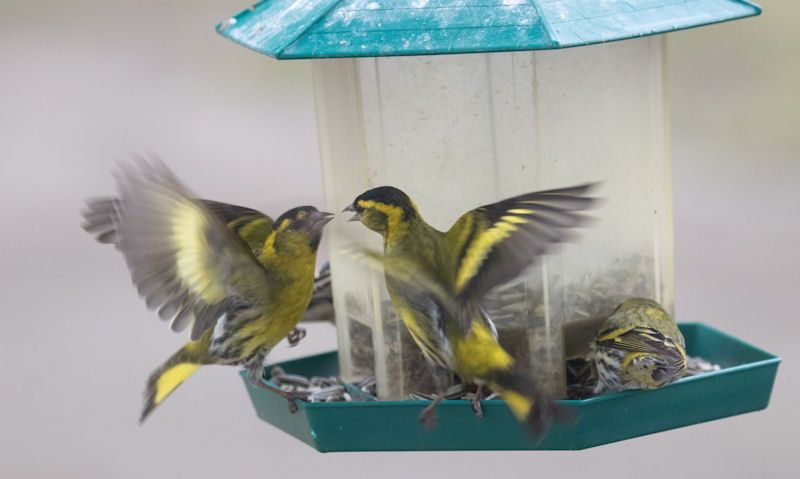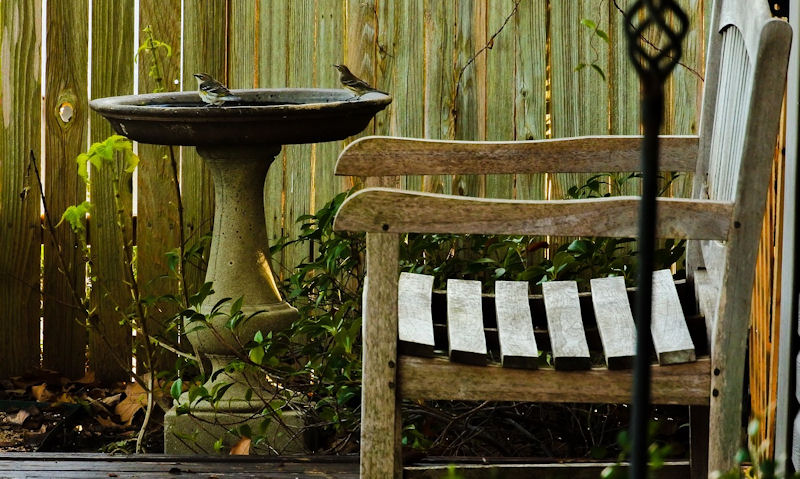What bird feeders should I use
You only need up to three bird feeders to hang up off a bracket or a branch, as its only suet, peanuts or seeds that are mostly consumed by common garden birds.
What bird feeders should you use is one or two of a suet fat ball feeder, peanut feeder, seed feeder and an open tray for use with popular wild bird food, or used less - but still a favourite with birds. All of these feeders are the most commonly used in the UK, and a favourite with British garden birds.
No need to make it difficult on yourself, as the types of wild bird feeders needed to get up and running with quick success is a peanut, seed or suet feeder.
To buy a bird feeding station or a set of bird feeders, all of the above would be included in the pack - and that is due to how popular they are with their use in British gardens.
Feeders to hold suet can be in fat balls, suet block or cake form - or use a clear plastic tube to hold suet pellets. Don't get lost in what to use when going back to a basic yet reliable readily available fat ball or block feeder is used most and must be consider above all else.
Be sure to hang up a seed feeder for all seed mixes only, as one for Sunflower or Nyjer seeds can be restricted to which bird species feed off them.
Classic bird seed feeder for hanging is best, with a 2-4 feeding port option with perches.
Where else you can't go wrong is feeding the most common birds protein-rich nuts in a special mesh surround peanut bird feeder.
With all that in mind, its then time to turn to an open tray for feeding more birds, as not all can cling off a bird feeder. But to use a mesh tray can offer drainage but an option for a bird feeding tray with dome for cover is an option.
SUET in block or ball style
While most people would associate a bird feeder to hold seed or peanuts the most, its actually the suet that would be eaten up most, in my opinion.
What bird feeders should you use then would be one or two of suet feeders.
Safe, tried and tested fat ball bird feeders would be the go to feeder of choice, as they're widely available in-store or online - with only a visit to Asda or Tesco to buy a bird feeder of this kind.
Proof then the bird feeder to hold fat balls is a popular one, or else they wouldn't be sold so openly.
Difficulty though is what types of a suet fat balls for wild birds should you use; there are seeds, peanuts or the mealworm kind - so consider using a mix of them all to cater to as many common garden birds as possible who do munch on suet.
What else you can consider is offering suet in the block or cake form, or why not use suet pellets to replenish a specialty suet pellet bird feeder, similar to a seed feeder.
Effective mesh NUT feeder
No shortage of our British garden birds who feed off peanut feeders, so its vital to make this one - one of the four of my options laid out for you.
It can be a small or large peanut bird feeder that uses a metal mesh shroud.
It can be in a long or short rounded feeder for hanging, or similarly a mesh feeder that replicates an acorn or a donut shape.
The point is for wild birds to clamber onto the mesh surround as to peck through the small open gaps to feed off the peanuts trapped behind the mesh.
Hang up the peanut bird feeder near the seed feeder to see how quickly both of these feeders would be purge of their contents.
Easy to open bird feeder too as it only requires a lift up of the lid to replenish with fresh peanuts - then use the attached hanger for hanging off a bracket.
Small, light plastic SEED mix feeder
No limit to the amount of garden birds you can bring to a seed bird feeder, and as its mostly for small birds, its certainly can keep off more nuisance birds.
Cheap to buy wild bird mixes can be bought just about anywhere, at little cost for a small bag, or for a large bulk buy bag of wild bird seeds which don't cost much more.
Seeds feeders are an important type of feeder that would offer up to many of the Tit family, Robins and many of the Finches.
Seed feeders can accommodate seed mixes that contain oats, wheat or crushed nuts, but specialty seed feeders can be used.
I do recommend sticking to a standard bird feeder for all seed mixes.
Made in a clear plastic tube, the seed feeder can contain two feeding parts for a small feeder, or up to 4-6 port holes if its a large bird feeder for seed mixes.
Open fixed or hanging tray
That finally brings me to the fourth and final feeder of my what bird feeders should you use in your garden.
Not all common garden birds are capable of feeding off a hanging bird feeder, so will rely on spilt food on the ground or an open tray - which is what I recommend now.
Now, it is possible to find a open plastic tray mounted on your bird feeder, likewise an open tray could be half way up the post of the bird table.
But its vital its offered anyway possible so the large, less agile birds can feed.
Easy to hang off a bracket or branch, yet even easier to replenish with any kind of feed imaginable - including the need to offer dried mealworms for wild birds - of which I don't really recommend buying a specialty feeder unless you plan to use it all the time.
Open bird trays can bring in Starlings or Dunnocks, but so to more nuisance birds such as pigeons, so be warned.
Hang the open bird feeding tray above feeders that would otherwise result in feed or bird poop dropping into the tray below it - but its also vital to have it high up anyway.
Bird Feeding Station to hang them all
So far I recommend you have at least one of the following; a suet feeder for fat balls, peanut feeder, seed feeder and an open tray as to not restrict certain wild bird species.
However, its not possible to hang all four unless you have the bracket or a branch on a tree to hang them all.
I therefore recommend you buy a bird feeding station with feeders I've mentioned thus far, or why not buy a bird feeding station with pole only - to then buy what bird feeders you'd prefer.
Its important to fix a bird feeder bracket to a wall or fence to try different locations around the garden, but its more important to centralise the feeding area with use of a bird feeding station or bird table.
Bird table for accommodating non-bird feeder users, but so to can this wooden bird table feeding platform be used to hang off all types of bird feeders.
If you have a bird feeding station then there's no limit to what you can hang, but remember you'd need a minimum of four brackets to use all four bird feeder options I've told you to use.
What else to consider
I would say of the suet, peanut, seed and open feeding tray I recommend you should at least use one of - they're all found to be easy to clean or replenish.
Sure, it can be more tricky using a novelty feeder to hold nuts or seeds, but as a rule of thumb, it usually involves simply lifting up the lid to open.
However, not all common garden birds can use bird feeders, while limited to a bird table or large open tray only - so its important to feed them too.
What are known as ground feeding birds, its important not to forget what could be Chaffinch's, Doves, Blackbirds, Dunnocks, Sparrows, Robins, Siskins, Pigeons - if only you want to feed them - Starlings or Wrens who would go without.
With the exception of Chaffinch's, Sparrows, Robins and even Siskins who can use hanging bird feeders, the others are limited to feeding off the ground.
With that in mind you could lay out a ground bird feeder or more conveniently, throw over specialty ground feeding mixes, or use seeds, peanuts or suet pellets that are also used for the feeders on the lawn.
Conclusion
I know seeds and peanut feeders should be recommended by me first and foremost, but I do see the suet get gobbled up far sooner than anything else.
I would then recommend hanging up a fat ball feeder, or else use a suet block/cake feeder, or a suet pellet feeder if you must.
However, the reason why fat ball feeders are so popular is because they are more accessible - so remember that before purchasing more restricted bird feeders as you'd soon forget about your goals.
On to my second option would be of course the favourable peanut feeder, designed to hold nuts while accessed through a metal mesh surround.
Over to the classic bird seed feeder which has up to 2-6 feeding ports, along with a corresponding perch fixed on the outside of each port hole. And while popular with lots of garden birds, a seed feeder can only accommodate smaller birds.
To open up your bird feeding area to more, yet larger garden bird species, the use of a hanging bird feeding tray would do the trick.
Designed to hold any wild bird food imaginable, including household scraps, dried or live mealworms - an open tray must be hung as the mesh tray would allow moisture or rain to drain through.
All bird feeders must be hung up together in a centralised location, so unless you have the tree, its important to setup a bird feeding station with a minimum of four brackets.


